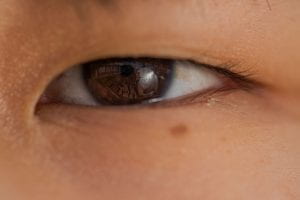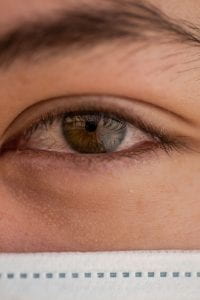In my previous In-Depth blog post, my mentor and I again discussed taking images of snow since there was a small period immediately after my last blog post where it was supposed to do so. Unfortunately, I missed the snowfall, however, my mentor and I had planned on this by setting an alternative challenge if it was necessary. The challenge he requested for me to attempt was photography of the eyes. He made sure to really stress about how the focus and focal range are important as well as how the exposure is equally as important.
We began this week’s meeting by showing him the first two images of an eye that belongs to my peer, Sinu. Using the “white hat,” my mentor and I immediately identified how we knew that the picture was out of focus. He asked me why I added it, since it obviously isn’t too great, to which I responded, while using the “red hat,” about how I felt that since the eye was out of focus, it created a more inviting feeling rather than a harsh and sharp sensation you can get from an eye that is tack sharp. My mentor strongly disagreed with me, using the “black hat,” making sure for me to know how it wasn’t what he assigned and that it didn’t fulfil the objective, however; the second photograph was something he enjoyed much more.
Although the eye itself wasn’t exactly in focus, he thought that having the reflection be in focus could be just as fascinating. Looking into the reflection of the eye, we were easily able to see the camera and myself, but my mentor wasn’t expecting to be able to make out what I was wearing and even the school in the background. We both were totally blown away. Using the “green hat,” I pitched to my mentor the idea of utilizing this technique to take photos of people’s eyes with even more beautiful backgrounds such as a sunrise/sunset or even breathtaking mountains. Although he liked my idea, we agreed that that isn’t realistically obtainable with the current Covid-19 restrictions. In addition, my mentor took a more symbolic route when talking about the large circular bounce that appears in the eye. He thought it resembled a planet with its curvature as well as how the light is reflecting off its surface. I assume he was using his “red hat” because he was expressing his intuition. This time, I was the one using the “black hat” to point out that that was not my own objective while taking the picture.
I introduced this imagine by explaining to him why the subject, Justin’s, eyes were watery and red. What happened was that the light that was being omitted by the bounce, which reflects the light from the sun, was very bright for him so it was challenging him to keep his eyes open. This resulted in his eyes beginning to water as well as become red. All of that aside, my mentor preferred this image far more than the last because of how less visible I am in the frame. It’s as if I’m hiding inside his pupil. My mentor and I both agreed about how we preferred the framing of the eyebrow in the frame over the other photos. My mentor used his “red hat” while describing how the eyebrow felt as though it was framing his face as well as allowing the viewer’s eyes follow along the image with the curvature of his eyes and eyebrows. In addition, my mentor and I agreed that the mask in the lower area of the frame could have been cropped out or even slightly lowered to perfect the shot. Moreover, he loved how much detail was captured within the eye itself with all the vibrant colours that could really be brought out even more if I were to edit the image in Lightroom.
In the second image, the watery eyes are much more evident especially along his lower eyelids where there is some moisture in focus. Although my mentor and I used our “white hats” and knew that the white circle in his eye was the bounce, we also used it to point out the less-than-ideal framing. We both agreed on how the shot should have been taken with the eye lower down in the frame to either create more free space above the eye or allow for his eyebrow to show since we enjoyed it being in the last picture. Beside my camera and I remaining hidden in his pupil, I am very proud of capturing Justin’s eyelashes in the reflection of his eyes, which is something my mentor pointed out to me while reviewing the photo. In addition, he pointed out the slight lens flare in the corner of Justin’s eye. I questioned whether that was a flare or just some goop. My mentor used his “black hat” to point out the fault in information by showing how the other side of the eye has a small amount of goop in focus whereas the eyelashes around the other mystery substance are all in focus. For that not to be in focus, it would be a strange issue with the camera. We eventually agreed on the conclusion of it being a lens flare with the eye.
In conclusion, I am extremely proud of my progress this week through the issues of focus and framing and I can’t wait to show my improvements in my following In-Depth blog post. Although I didn’t find a good example of my mentor and I using our “yellow and blue hats,” I can pay more attention to them in our future meetings and point them out in my subsequent blog posts. For my next blog post, my mentor has challenged me to take photos of flowers since it’s becoming spring and they are going to begin blooming soon. He recommends getting up close to the buds and almost shoving the camera inside of the flowers to get a better macro shot. I am extremely excited to see how these will turn out.



